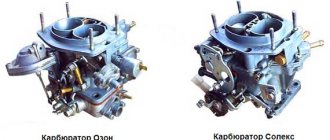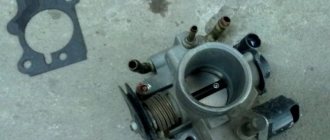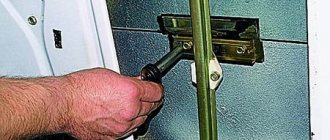Many drivers, especially beginners, wonder whether it is possible to effectively flush the injector with their own hands or whether it is necessary to contact a service station, that is, to knowledgeable specialists. The answer to this question depends on many factors, but in most cases, cleaning the injectors yourself is not a particular problem.
- Self-cleaning of injectors, video:
To work independently, some preparation is required. You need to know your car well enough to avoid making fatal mistakes.
You also need to stock up on the appropriate equipment, tools and chemicals, get advice from specialists, and carefully study the instructions for both the machine and the flushing fluid. After this, you can start cleaning.
It should be noted that cleaning injectors yourself is quite popular. The main incentive for the demand for this method of self-care for your own vehicle is the fairly high cost of the work.
A justified desire to save money leads to a search for other ways to solve the problem than going to a service station.
But here we need to pay attention to the other side of the issue. Improper cleaning may result in the need to purchase a new set of nozzles, which can cost tens of thousands of rubles.
When is it necessary to clean injectors?
The injector is a fuel injection system. This is a rather complex unit. Depending on the specific case, in addition to the electric fuel pump, it includes a control system, pressure regulators, as well as many different sensors for measuring the parameters of fuel, intake air and other objects.
A significant disadvantage of the injector is that when using low-quality fuel, it becomes clogged quite quickly and does not work efficiently. Then the question arises about cleaning the injector.
Depending on the characteristics of the injection system and the fuel used, it is recommended to clean it after every 20 thousand kilometers or more.
But there are a number of signs that indicate that cleaning the injector is already necessary. These are the signs:
- fuel consumption has increased;
- the engine fails to achieve full power;
- smoky air comes out of the muffler;
- engine idling is uneven;
- The engine starts harder than usual;
- spark plugs are dirty.
Of course, there can be many reasons for engine performance deterioration. If in doubt, it is natural that it is better to contact specialists, a service station.
Why do you need to clean injectors?
Without knowing the principle of operation of the sprayer, it is impossible to understand why dirt getting inside the device negatively affects the operation of the car.
The device supplies fuel to the intake manifold or cylinder tank, where it mixes with air and then burns.
Before injection, gasoline must be finely dispersed (look like fog) - the injector is responsible for this. If this factor is observed, the best conditions for fuel combustion are created. The atomizer contains many holes supplying fuel. If the device is full of dirt particles, the small holes become clogged, which is why the fuel begins to flow not as a mist, but as a stream, which poorly forms an air-fuel mixture.
The consequence of this problem is incomplete combustion of gasoline.
The car begins to consume more gasoline, the power of the iron horse drops, and periodic failures also occur.
Injector cleaning products
The liquid for flushing injectors should be selected carefully and accurately. If the choice is made incorrectly, then, as mentioned above, you will have to buy new injectors, and all attempts to save on the cost of work will be in vain.
The most commonly used injector flush fluid is Wynn's. The product, which is commonly called Vince, is considered potent.
It is most suitable for cases where the injector is very dirty and carbon deposits have formed on the valves and combustion chambers. Experts recommend using this drug for fairly old cars.
For new cars, Vince is undesirable, and in many cases it can be not only harmful, it can cause large unplanned costs. In any case, the spark plugs will definitely have to be changed.
On the contrary, LIQUI MOLY will save candles and you won’t have to change them. But this injector cleaning fluid is completely unsuitable for removing carbon deposits from the valves.
What's great about LIQUI MOLY is its versatility. It is not harmful to injectors.
Laurel flushing fluid resembles Wynn's in its effect on the injection system. But its main drawback is the cost. Due to its high price, laurel is rarely used by both professionals and amateurs.
The market offers a huge number of brands of flushing fluids for injection systems. It should be remembered that careful selection is especially important.
Signs of clogged injector nozzles
If the problem still cannot be avoided, there are several signs by which you can determine that it is necessary to clean the injectors much earlier:
- Loss of engine power (a small amount of fuel-air mixture is supplied to the combustion chamber);
- Increased fuel consumption;
- Periodic pops (detonation) while the engine is running;
- Exhaust of black smoke from a car muffler;
- Unstable engine operation (engine speed jumps).
It is worth noting that if any of the above symptoms appear, you should not immediately try to clean the injector. The fact is that the cause of the malfunction may be other problems in the system, for example, a clogged particulate filter or a breakdown of another part. In any case, first you need to conduct a thorough diagnosis of the engine, and only then, after making sure that the injectors are clogged, proceed to flushing the injector.
Equipment for self-cleaning the injector
It makes the most sense to use a stand for washing injectors . It is difficult to say whether it makes sense to buy factory-made equipment. It is quite expensive; for periodic work such a purchase is hardly justified.
But equipment for washing the injector without removing the injectors can be made independently, mostly from scrap materials. For this you will need:
- an ordinary two-liter mineral water bottle;
- two meters of rubber hose;
- two nipples, such as those found in tubeless tires;
- four clamps for fastening the hose;
- liquid pump with pressure gauge;
- terminals, wires and other accessories.
Of course, the installation of such components will be too simple, but it works, in some cases no less effectively than industrial equipment.
You can purchase a ready-made system, or borrow it from friends. Once you have decided how to clean the injector nozzles at home, you should begin the cleaning process.
Do-it-yourself injector washing, video:
How does an injection engine work?
To understand the benefits of injector flushing , let's consider the principle of its operation using the example of an engine with direct injection. This system is called Directinjection. Diesel works in much the same way.
When an injector becomes clogged, the diameter of the nozzle changes. Fuel atomization deteriorates and the shape of the torch changes. This leads to the fact that the fuel does not burn completely. If you do not use injector flushing fluid , the situation will get worse.
Stages of clogging:
- At the first stage, the efficiency of the injection elements decreases unevenly. Some devices reduce productivity by up to 10% (some by only 3-5%). This leads to uneven operation of the cylinders. The engine consumes 1-2 liters of fuel more per 100 km. Low-quality gasoline detonates. The discomfort from driving is not yet obvious, but you can notice it.
- At the moderate stage, the efficiency of injection devices is reduced by 10-25%. At idle speed the engine “troubles”. Fuel consumption increases by 15-20%. The dynamic characteristics of the car are noticeably reduced. The exhaust acquires a pungent odor. Detonation is constantly present, the car “shoots”.
- At the third stage, the difference in the performance of injection devices reaches 50%. At idle, one or two cylinders sometimes shut down completely. If you sharply increase the gas, loud pops are heard. Additional consumption increases by 50-70%. Dips during acceleration do not allow you to move normally even in city traffic. At times it may feel like the engine is about to come off.
Chemical cleaning of the injector
Methods for chemically cleaning an injector include not only the use of the liquids described above. There are, for example, special fuel additives that to some extent clean the injectors and remove carbon deposits from the valves. But this is more of a preventive remedy; in case of severe contamination, it is not very effective.
Washing injectors without removing them from the engine consists of a number of steps.
- First of all, you need to turn off the fuel pump. To do this, it is enough to wait until the engine stalls on its own while the engine is running. The pressure in the fuel system will be relieved, you can begin to perform the main stages of work.
- Next, you need to connect the homemade installation hose and tighten the connection with a clamp. The clamp should fit securely enough so that there is no rupture during operation. The pressure in the system will reach approximately three atmospheres, so you should be careful.
- Return overlap. If this is not done, injector cleaning fluid may enter the tank, which is undesirable.
- Filling the flushing liquid into the container intended for it.
- Connecting the liquid pump to the power supply.
- Main stage. Before flushing the injectors, you should once again make sure that all connections are secure. At this stage, an assistant is needed to start the engine. Now you should start the liquid pump, bringing the pressure to three atmospheres. That's it, the cleaning process has begun. Depending on the amount of flushing fluid used, cleaning the injectors will last from ten to twenty minutes. The standard amount of Vince per car is 500 milliliters. You just need to wait for it to end.
- Visually check the exhaust. If cleaning is effective, there should be no smoke at the end of the injector flushing process.
- Replace spark plugs if necessary.
- Finally, you need to turn off the homemade injector washing device and restore the system, that is, connect all the hoses, connect the fuel pump fuse, and the like.
- Check engine operation after flushing. If previously detected problems no longer appear in any way, then the flushing was carried out effectively.
Experts say that high-quality injector flushing can significantly reduce fuel consumption. It would probably be more correct to consider bringing fuel consumption back to normal. In any case, there is the possibility of significant savings on gasoline or diesel fuel.
Self-cleaning of diesel injectors is carried out in exactly the same way as flushing gasoline injectors. The homemade installation described above is quite suitable, and so is the operating algorithm. Of course, cleaning diesel injectors requires careful selection of flushing fluid and a certain amount of accuracy in work.
You can also wash the injectors yourself by removing them from the engine. There is a special spray for this, and the cleaning installation is different from the one described above.
You can wash the injector with your own hands this way, and quite effectively, but it is a longer and more complex process.
Self-cleaning of injectors, video:
Cleaning Frequency
Car or injector manufacturers rarely indicate the frequency of routine maintenance to clean fuel system components. However, clogging is inevitable, no matter how the car is used. As a rule, this happens due to low quality fuel and the presence of foreign impurities in it. The filter removes the latter, but it cannot completely prevent the entry of pollutants.
Car service workers recommend using cleaners to clean the fuel system of a gasoline engine every 15-25 thousand km. The frequency of the procedure depends on the quality of the fuel being poured and the year of manufacture of the vehicle. The older the car, the more dirt accumulates in its power system. In this case, adding an additive to gasoline to clean/clean injectors can only worsen the situation - dissolved impurities will completely clog the injector nozzles. It is better to pour injector cleaner into the tank after washing it and all lines, as well as replacing the fuel filter.
Cleaning nozzles in ultrasonic baths
An ultrasonic bath for cleaning injectors is quite expensive equipment; it is used only at service stations.
The injectors must be removed from the engine and placed in such a bath. There they are cleaned using the cavitation effect. The cleaning process itself is multi-stage. After the first stage, the quality of the cut and the level of productivity are checked on a special stand.
Then another wash follows, followed by another check, and so on until the required result is achieved. One of the criteria for the readiness of injectors for further operation is a slight difference in their performance. It should be no more than one to three percent.
After the washing in the ultrasonic bath has been successfully completed, the sealing filters and rings must be replaced, if necessary.
Like all processes, ultrasonic injector cleaning has its pros and cons.
One of the main advantages of this method of cleaning the injector is the ability to remove very strong contaminants. Where liquid flushing simply won’t help, ultrasonic flushing can do the job.
But this method is far from omnipotent either. It happens that it is impossible to wash the injectors. This happens especially often if water gets into the fuel tank or the car has not been used for a long time. In this case, the service station will offer to check the injectors on a stand to determine whether they can still be used or should be replaced.
Reviews about ultrasonic cleaning of injectors are often negative. There are reasons for this when the service station employees incorrectly determined the method of cleaning the injector. It may well be that washing injectors from a car that was produced quite a long time ago in an ultrasonic bath can be effective.
At the same time, the use of such a potent agent on relatively new products can lead to disastrous results. The injectors may simply fall apart.
The quality of ultrasonic cleaning of injectors depends on many factors. This is the selection of equipment, the more modern it is, the better. This is also the selection of liquid with which ultrasonic baths are filled.
But the main thing remains the human factor. The qualifications of the service station employees, as well as their conscientious work, will determine the quality of ultrasonic cleaning of the injector.
Injection motor power supply system
The supply of fuel to the engine cylinders using injectors has become widespread in cars of the latest generations. Compared to carburetor systems, injection systems are more economical and their exhaust gases are less toxic. In addition, controlled fuel injection allows for higher torque on the output shaft. Components included in the injection engine power system:
- Electric gasoline pump. It is installed in the fuel tank, from where it supplies gasoline. As a rule, the pump is combined into one module with a coarse filter and a float fuel level indicator.
- Fuel lines. They connect all components of the system into one whole. They are made from petrol-resistant rubber, polymers or metal.
- Fine filter. The element is installed in the rupture of the fuel supply line after the fuel pump. It is necessary to filter gasoline supplied to the injectors. If it is clogged or damaged, dirt, getting into the nozzles along with the fuel, clogs them, which leads to engine malfunctions.
- Fuel rail. It serves as a buffer tank for the accumulation of gasoline and is an injector holder.
- Fuel pressure control. Maintains a given characteristic to ensure stable engine operation.
- Injectors. Injectors with shut-off solenoid valves designed for metered fuel supply into the engine intake manifold.
- Sensors that transmit information about the operating parameters of the power unit to the control controller.
For stable operation of an internal combustion engine in all modes, it needs a constant and balanced supply of a fuel mixture of gasoline and air.
Accurate dosing of fuel is carried out by injectors based on a signal from the electronic control unit. The solenoid valves, when energized, open for a fraction of a second to allow pressurized gasoline to be injected into the intake manifold. Electronics, controlling the duration of opening, regulates the quality of the fuel mixture. For your information!
The correct preparation of the flammable composition is monitored by a lambda probe located in the exhaust manifold. Based on its signal, the electronics enriches or leans the fuel mixture.











